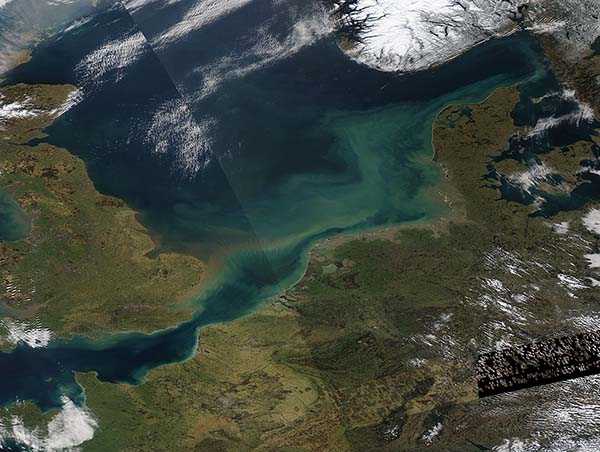Images
March 1, 2022 - Sediment in the North Sea
Tweet
Swirls of sediment snake through the shallow waters of the North Sea in late February 2022. The Moderate Resolution Imaging Spectroradiometer (MODIS) on board NASA’s Aqua satellite acquired a true-color image of the silty scene on February 27.
Mud-colored sediment is visible in the River Thames, which runs through the city of London, England and empties into the shallow Thames Estuary on the southeastern section of the island of Great Britain. Further north along the British coast sediment spills from several rivers, including River Great Ouse and River Nene, into an estuary called the Wash. These two sources mix with sediment raised from the shallow and sand-rich intertidal flats of the Outer Thames Estuary where the winnowing action of the waves and local currents carry the particles far into the North Sea.
Sediment appears mud-colored when it floats near the surface of the water but, as it sinks and disperses, its reflectivity changes and the appearance changes from brown to green. As sediment sinks even deeper, it may begin to look blue. Some of the color in this image may also be due to the presence of phytoplankton—microscopic plant-like organisms that live in these waters year-round but may burst into vigorous growth when conditions are right to form large, colorful blooms. Nutrients supplied by sediment and carried along the currents helps spur spring and summer blooms in the North Sea.
Image Facts
Satellite:
Aqua
Date Acquired: 2/27/2022
Resolutions:
1km (428.5 KB), 500m (1.2 MB), 250m (4.6 MB)
Bands Used: 1,4,3
Image Credit:
MODIS Land Rapid Response Team, NASA GSFC
Tweet
Swirls of sediment snake through the shallow waters of the North Sea in late February 2022. The Moderate Resolution Imaging Spectroradiometer (MODIS) on board NASA’s Aqua satellite acquired a true-color image of the silty scene on February 27.
Mud-colored sediment is visible in the River Thames, which runs through the city of London, England and empties into the shallow Thames Estuary on the southeastern section of the island of Great Britain. Further north along the British coast sediment spills from several rivers, including River Great Ouse and River Nene, into an estuary called the Wash. These two sources mix with sediment raised from the shallow and sand-rich intertidal flats of the Outer Thames Estuary where the winnowing action of the waves and local currents carry the particles far into the North Sea.
Sediment appears mud-colored when it floats near the surface of the water but, as it sinks and disperses, its reflectivity changes and the appearance changes from brown to green. As sediment sinks even deeper, it may begin to look blue. Some of the color in this image may also be due to the presence of phytoplankton—microscopic plant-like organisms that live in these waters year-round but may burst into vigorous growth when conditions are right to form large, colorful blooms. Nutrients supplied by sediment and carried along the currents helps spur spring and summer blooms in the North Sea.
Image Facts
Satellite:
Aqua
Date Acquired: 2/27/2022
Resolutions:
1km (428.5 KB), 500m (1.2 MB), 250m (4.6 MB)
Bands Used: 1,4,3
Image Credit:
MODIS Land Rapid Response Team, NASA GSFC




